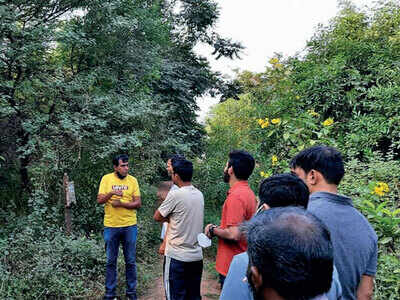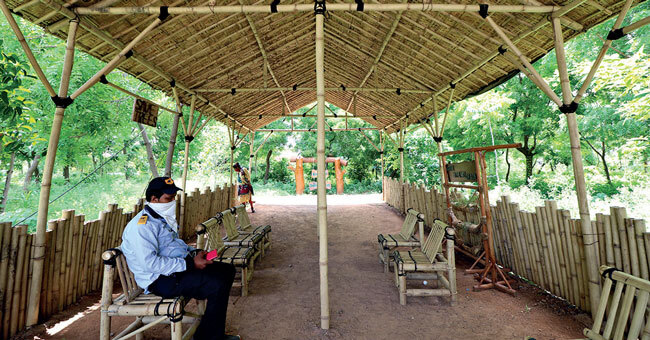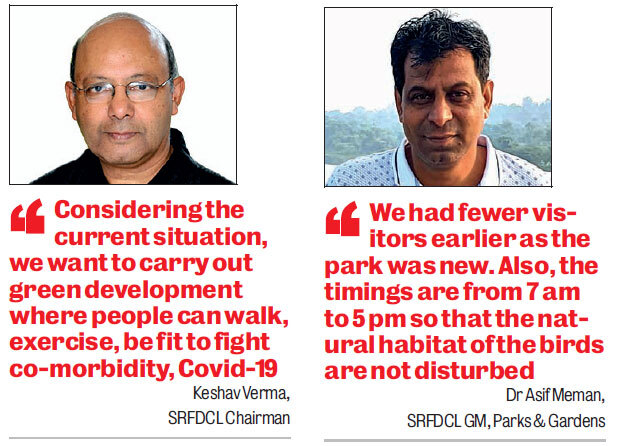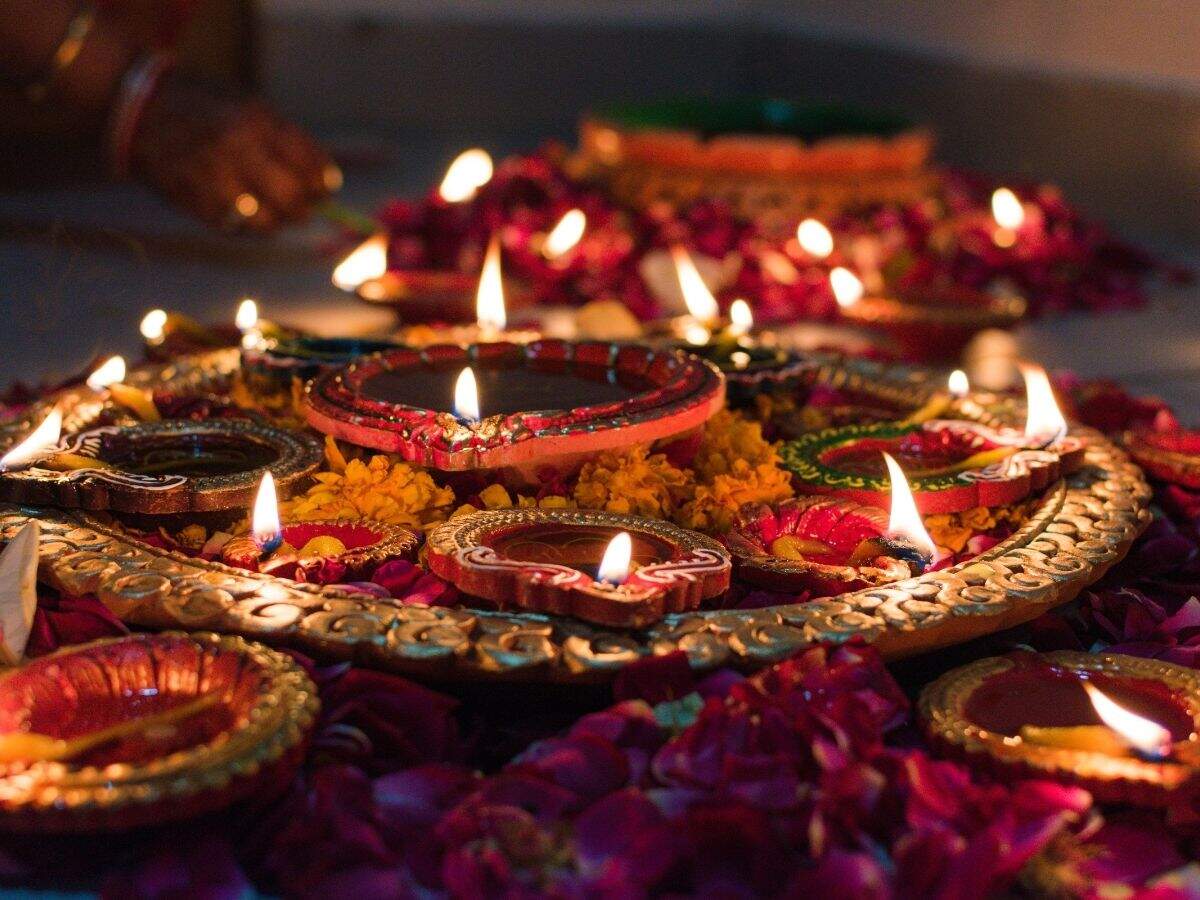Footfalls soar at biodiversity park

Developed over seven years at a cost of Rs 78 lakh, the park has several variety of trees
From around 150-200 visitors on weekends, there are now 300 visitors who tour the park before visiting the adjoining aerodrome
The launch of theseaplane has not boosted just tourism, but also the number of visitors to the nearby Biodiversity Park on the Sabarmati Riverfront. Following the launch of the seaplane, the park has seen as much as 50 per cent rise in visitors.
Located below the Ambedkar Bridge in Paldi, the park used to get around 150 to 200 visitors on weekends, before the seaplane’s launch. Since then, the park has witnessed a spike in visitors at the park, both on weekdays and weekends.
“Earlier, during weekends, we used to get 150 to 200 visitors. However, since the seaplane has launched, we have seen a surge in visitors. We have been receiving around 300 visitors on weekends. During the week, we would get about 30 visitors. We have seen a rise in this figure, too.”

Dr Meman said, “People prefer to visit the park in the morning, then visit the seaplane at the aerodrome adjoining the park.”
Kitchen garden, nursery Developed over seven years at a cost of Rs 78 lakh, the park has several variety of trees. Unlike other public gardens, it has several fruit-bearing trees including sweet lime (mosambi), pomegranate (daadam), sapota (chikoo),Manilkara hexandra (rayan), Cordia myxa (gunda), Madhuca longifolia (mahuda), Terminalia bellirica (baheda), cherry, mulberry, soapnuts (areetha), seagrape, drumsticks (saragvo), etc along with plants like pineapple . Other varieties include neem, bamboo, asopalav, etc.
The park also has ayurvedic plants like nagod, arjun sadadd, and ardusi among others. The trees have been grown using the Miyawaki technique of plantation.
Pioneered by Japanese botanist Akira Miyawaki, the Miyawaki forestation method is a unique way to create an urban forest. With this method of plantation, an urban forest can grow within a short span of 20-30 years while a conventional forest takes around 200-300 years to grow naturally.

In the Miyawaki technique,various native species of plants are planted close to each other so that the plants receive sunlight only from the top and grow upwards than sideways. As a result, the plantation becomes approximately 30 times denser, grows 10 times faster and becomes maintenance-free after aspan of 3 years.
Thanks to the dense canopies, the park resembles a mini-forest, which is how it had been envisioned, say authorities. Instead of regular benches, seats carved out of wood have been placed in the park, adding to the forest ambience.
The park is spread over 20,000 sq mof land and has 120 varieties of trees. So far, authorities have grown more than 7,000 trees. Now they are developing another 60,000 sq m (six hectares) in which they will have 30,000 trees of 153 indigenous species that can survive in the city’s climatic conditions.
As per an SRFDCL survey, as many as 36 species of birds visit the park in mornings and evenings. These include kingfishers, egrets, Indian silverbills, ibis, purple swamphen, sparrows, peacocks, and booted eagle. Butterflies also flitter about the park.
SRFDCL ChairmanKeshav Verma said, “Our aim is to develop a place for wellness through urban planning. Considering the current Covid-19 situation, we want to carry out green development around the river where people come and exercise, walk and be fit to fight against co-morbidity and Covid-19.”
The launch of the
Located below the Ambedkar Bridge in Paldi, the park used to get around 150 to 200 visitors on weekends, before the seaplane’s launch. Since then, the park has witnessed a spike in visitors at the park, both on weekdays and weekends.
General Manager of Parks and Gardens (SRFDCL) Dr Asif Meman said, “We had fewer visitors earlier as the park was new. Also, the timings are from 7 am to 5 pm so that the natural habitat of the birds are not disturbed.
“Earlier, during weekends, we used to get 150 to 200 visitors. However, since the seaplane has launched, we have seen a surge in visitors. We have been receiving around 300 visitors on weekends. During the week, we would get about 30 visitors. We have seen a rise in this figure, too.”

Thanks to the dense canopies, the park resembles a mini-forest
Dr Meman said, “People prefer to visit the park in the morning, then visit the seaplane at the aerodrome adjoining the park.”
Kitchen garden, nursery Developed over seven years at a cost of Rs 78 lakh, the park has several variety of trees. Unlike other public gardens, it has several fruit-bearing trees including sweet lime (mosambi), pomegranate (daadam), sapota (chikoo),
The park also has ayurvedic plants like nagod, arjun sadadd, and ardusi among others. The trees have been grown using the Miyawaki technique of plantation.
Pioneered by Japanese botanist Akira Miyawaki, the Miyawaki forestation method is a unique way to create an urban forest. With this method of plantation, an urban forest can grow within a short span of 20-30 years while a conventional forest takes around 200-300 years to grow naturally.

Quotes
In the Miyawaki technique,
Thanks to the dense canopies, the park resembles a mini-forest, which is how it had been envisioned, say authorities. Instead of regular benches, seats carved out of wood have been placed in the park, adding to the forest ambience.
The park is spread over 20,000 sq mof land and has 120 varieties of trees. So far, authorities have grown more than 7,000 trees. Now they are developing another 60,000 sq m (six hectares) in which they will have 30,000 trees of 153 indigenous species that can survive in the city’s climatic conditions.
As per an SRFDCL survey, as many as 36 species of birds visit the park in mornings and evenings. These include kingfishers, egrets, Indian silverbills, ibis, purple swamphen, sparrows, peacocks, and booted eagle. Butterflies also flitter about the park.
SRFDCL Chairman
GALLERIES View more photos


























Recent Messages ()
Please rate before posting your Review
SIGN IN WITH
Refrain from posting comments that are obscene, defamatory or inflammatory, and do not indulge in personal attacks, name calling or inciting hatred against any community. Help us delete comments that do not follow these guidelines by marking them offensive. Let's work together to keep the conversation civil.